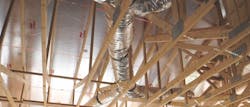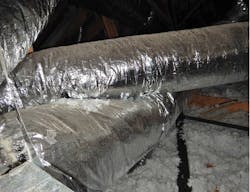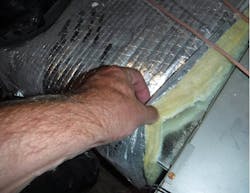Flexible HVAC Ductwork Best Practices: Smooth, Sealed, and Separated
Although it’s not ideal to run air conditioning ducts through a hot attic, it’s a fact of life in most new homes. In this extreme environment, however, ducts can only do their job if they’re properly detailed. Many aren’t.
Fortunately, observing the condition of the flex duct jacket can be a straightforward QA inspection. It’s a matter of making sure that the jacket is smooth, sealed, and separated.
HVAC Ducts Done Wrong
In my experience, only a minority of production homes have well-detailed ductwork. Most have poor airflow, leaks, and a high probability of condensation in humid climates. The causes include two you probably know about, and two you may not be familiar with.
Most builders have heard the advice (even if they don’t require it) that pulling flex duct tight and avoiding sharp bends ensures good airflow and that they need to seal all connections. Inspecting these is a matter of confirming that the outer jacket is smooth and not wrinkled, that the duct has been pulled tight, and that the installer has put mastic/tape on the connections.
Less understood, but equally important:
1. Sealing the outer vapor jacket. This is as critical as sealing the inner flexible core.
2. Avoid crimping. Crimping or compressing the insulation invites condensation.
Even builders that have been made aware of these issues often ignore them, trusting the trade to do what is right. That may get the job done faster, but it’s asking for trouble.
RELATED
- Read more about Getting HVAC Right, for a trouble-free system
- Fire Safety: A Guide for Preventing Dryer Vent Fires
How to Maintain R-Value
Fiberglass insulation only reaches its total R-value if it’s not compressed and when it is fully encapsulated and airtight. In the case of flex ductwork, the thin outer vapor jacket is what provides that encapsulation. Even small gaps or tears in the jacket can expose the insulation and core, with consequences that go beyond heat loss, allowing the core to get cold enough to act as a condensing surface for hot-humid attic air.
That makes it important to repair tears or damage in the jacket with duct tape listed and labeled to UL Standard 181B.
Another common problem is compressed duct insulation. I see a lot of cases where the installers have laid one duct on top of another, compressing the insulation in both, or where they have spread the hanging straps so far apart that the weight of the duct causes deep crimps at the strap locations.
Because crimping or compressing the insulation reduces its R-value whenever the AC is running, that location can get cold enough for air to condense on it. In fact, I’ve seen inspectors insert their hand between two ducts and pull it out totally wet. The condensation can then begin dripping onto the attic insulation, damaging the insulation and the ceiling board.
The bottom line is that when putting ducts in the attic, follow the three S’s: Make sure the jacket is smooth, sealed, and separated. (Photos: courtesy IBACOS)
Arlan Burdick drives quality and performance in home building as a building performance specialist on the PERFORM Builder Solutions team at IBACOS.




